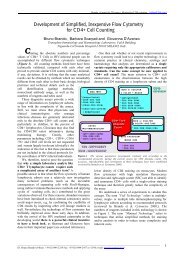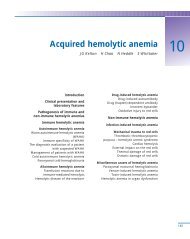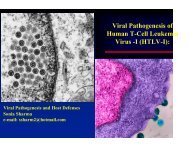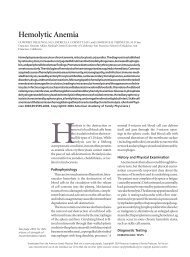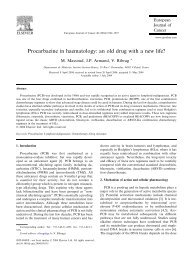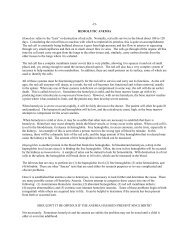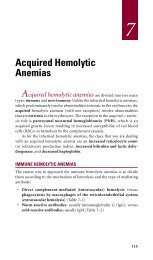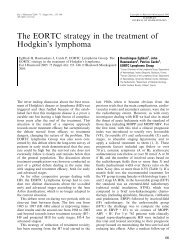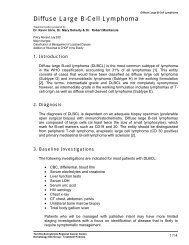Molecular basis of Diamond-Blackfan anemia: new findings from the ...
Molecular basis of Diamond-Blackfan anemia: new findings from the ...
Molecular basis of Diamond-Blackfan anemia: new findings from the ...
You also want an ePaper? Increase the reach of your titles
YUMPU automatically turns print PDFs into web optimized ePapers that Google loves.
<strong>Diamond</strong>-<strong>Blackfan</strong> <strong>anemia</strong> in <strong>the</strong> Italian populationafter SCT. Seven patients (8.2%) had died, four <strong>from</strong> SCTrelatedcomplications and three <strong>from</strong> o<strong>the</strong>r causes.A number <strong>of</strong> patients, though, experience spontaneousremission. 12,40 Hematologic remission wasachieved by 21% <strong>of</strong> our patients (excluding patientswho underwent SCT) a median <strong>of</strong> 14.5 months afterdiagnosis (range: 7-82 months). Fourteen patients wereinitially steroid responders and two had never requiredany treatment due to mild <strong>anemia</strong>; only two were transfusion-dependent,suggesting that steroid-resistantpatients have a very low chance <strong>of</strong> remission.Cytopenia and malignanciesNeutropenia and/or thrombocytopenia are notuncommon and occurred in 13 patients (15%) in ourseries. The pathogenesis <strong>of</strong> cytopenia is unclear. Severalreports suggest that <strong>the</strong> hematopoietic defect insevere DBA may not be confined to <strong>the</strong> erythroid lineage.Giri et al. reported that long-term culture-initiatingcells (LTC-IC) are quantitatively equivalent in DBApatients and normal controls, but <strong>the</strong> average clonogeniccell output per LTC-IC is significantly lower inDBA patients. 15 Similarly, Santucci et al. demonstratedthat <strong>the</strong> ability <strong>of</strong> <strong>the</strong> enriched CD34 + bone marrow cellfraction to proliferate and differentiate in vitro along<strong>the</strong> granulo-macrophage pathway is impaired in someDBA patients. 41 Hamaguchi et al. reported both significantreduction <strong>of</strong> <strong>the</strong> proliferative recruitment <strong>of</strong>CD34 + CD38 − hematopoietic progenitors in DBA patientsand significant improvement <strong>of</strong> <strong>the</strong>ir proliferativecapacity in RPS19-deficient DBA patients followingenforced expression <strong>of</strong> RPS19 with lentiviral vectors. 42Conversely, we have documented <strong>the</strong> immune pathogenesis<strong>of</strong> cytopenia in three patients, only one <strong>of</strong>whom was transfusion-dependent. DBA, like o<strong>the</strong>r bonemarrow failure syndromes such as dyskeratosis congenita(MIM:305000), may thus predispose to autoimmuneprocesses, even in <strong>the</strong> absence <strong>of</strong> heavy exogenousantigenic stimulation, and cytopenia may be dueto increased peripheral destruction <strong>of</strong> blood cellsinstead <strong>of</strong> reduced production. The two hypo<strong>the</strong>ses arenot mutually exclusive.Like o<strong>the</strong>r marrow failure syndromes, DBA is associatedwith a slightly increased risk <strong>of</strong> cancer. Malignancieshave been reported in 29 patients: 8,13,23,43-56 15hematopoietic neoplasms, primarily acute non-lymphocyticleukemias and myelodysplastic syndromes, 5osteogenic sarcomas and 9 cases <strong>of</strong> o<strong>the</strong>r solid tumors(hepatocellular carcinoma, gastric and colorectal carcinomas,breast cancer, melanoma and rare sarcomas).No malignancies were observed in our series.Several reports suggest that iron overload, androgenuse and immunosuppression secondary to steroid <strong>the</strong>rapypredispose DBA patients to malignancies. 44,45,49 Fur<strong>the</strong>rmore,myeloid malignancies are not unexpected, asDBA primarily involves <strong>the</strong> intrinsic hematopoietic progenitor.Conversely, <strong>the</strong> pathogenesis <strong>of</strong> osteogenic sarcomais difficult to explain; since this malignancy hasbeen observed in o<strong>the</strong>r genetic disorders, such as hereditaryretinoblastoma and Li-Fraumeni syndrome, it hasbeen suggested that DBA could be added to <strong>the</strong> list <strong>of</strong>syndromes predisposing to osteogenic sarcoma. 56GeneticsRPS19 geneIn 1997, identification <strong>of</strong> a balanced reciprocaltranslocation t(X;19)(p21;q13) in a sporadic case <strong>of</strong> DBAsuggested <strong>the</strong> presence <strong>of</strong> a DBA locus on chromosome19q13 57 and this suggestion was fur<strong>the</strong>r supported bylinkage studies in multiplex families 58 and by <strong>the</strong> identification<strong>of</strong> microdeletions spanning this region insome DBA patients. 59 Subsequent cloning <strong>of</strong> <strong>the</strong> 19q13breakpoint <strong>from</strong> <strong>the</strong> DBA patient with t(X;19) revealedthat <strong>the</strong> gene responsible for <strong>the</strong> disease was RPS19. 60This gene encodes for <strong>the</strong> ribosomal protein (rp) S19,associated with <strong>the</strong> ribosomal 40S subunit, and isespressed ubiquitously in hematopoietic and nonhematopoietictissues. The involvement <strong>of</strong> RPS19 inDBA was confirmed by molecular analysis in a largergroup <strong>of</strong> patients: 3,60 mutations in <strong>the</strong> RPS19 gene wereidentified in approximately 25% <strong>of</strong> DBA subjects. Mutationsconstantly affect only one allele, and, in multiplexfamilies, co-segregate with <strong>the</strong> DBA phenotype in consecutivegenerations with an autosomal dominantmode <strong>of</strong> transmission.More than sixty RPS19 mutations, scattered over <strong>the</strong>whole gene, have now been described. 3-5,59,61,62 Missense,nonsense, insertions, deletions and splice sitedefects have been found (Table 2). Eleven mutationsrecur in more than one patient; <strong>the</strong> particularly frequentones are <strong>the</strong> nonsense mutation Arg94Stop (6patients) and <strong>the</strong> missense mutations Arg62Trp (9patients) and Arg56Gln (5 patients). A hot spot <strong>of</strong> missensemutations was identified between codons 52 and62 (5 mutations in 18/60 overall patients), a highly conservedregion likely to have a critical role in RPS19 function.3RPS19 carried a mutation in 24.7% <strong>of</strong> our families. In<strong>the</strong> present study, which includes 25 <strong>new</strong> patients, wedescribe five <strong>new</strong> sporadic mutations: a chromosomaltranslocation with a wide deletion and four point mutations.In <strong>the</strong> first patient, a female with translocationt(1;19)(p32; q13), microsatellite analysis demonstrateda deletion on 19q13 which included markers CEA andPG1 flanking <strong>the</strong> RPS19 gene, indicating loss <strong>of</strong> <strong>the</strong>paternal RPS19 allele. Because paternal D19S197 andLIPE markers were conserved, <strong>the</strong> deletion was predictedto span about 1 Mb. The patient presented both DBAhaematologica 2004; 89(4):April 2004483



